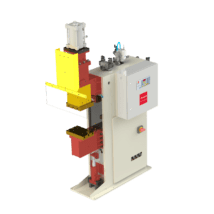- Products
- »
- Standard welding machines
- »
- Projection welders
Projection welders are used to join elements at special technological protrusions, so-called projections. The function of projections can also be performed by fragments of the elements to be joined (e.g. the edge of an opening). Projection welders make it possible to join metal parts for which spot welding would be difficult or impossible. For this task, special welding jigs ideally adapted to the elements to be welded are required (they are an additional accessory of the welding machine). Once the parts to be joined are attached and properly pressed together, the flow of current causes the “humps” to melt and a metallic connection to appear in their place. Hump welders are equipped with a modern microprocessor control system, which allows precise setting of the process parameters (current, welding time and clamping force), as well as stabilizing the welding current with changes in supply voltage.
These devices also have special pressure systems with a block of springs, whose task is to minimize the ejection of material during the rapid melting of the “hump”. The self-diagnostic system installed in the projection welders provides constant control of their condition, thus increasing their reliability, protecting them from damage and making it easier to locate possible faults.
By using a proportional valve in the welding machine, it is possible to electronically program the clamping force and modulate the clamping force during welding.
MFDC medium-frequency technology (“i” marked welders)
The MFDC range of medium frequency inverter resistance welding machines is the best answer to the growing demand for quality in resistance welding applications. Constant current control, fast millisecond current control, high quality and excellent control of energy transferred to the weld nucleus are the main advantages over traditional 50 Hz units. MF models fully meet the toughest industrial applications in mass production. Their characteristics make them ideal for spot resistance welding of small thicknesses and hard-to-weld materials such as copper, brass, aluminum alloys, galvanized and other coated steel.
Advantages of MFDC 1000Hz medium frequency inverter technology
- Ability to make high-quality connections on materials that are difficult to weld
- Excellent properties when welding pure aluminum or its weldable alloys, copper and brass
- Ability to reduce welding time to a few milliseconds, leading to savings in welding time and increased electrode life
- Fast ramp-up to the set welding current
- High efficiency and power factor
- Symmetrical load on three phases of the network
- Lower energy costs by reducing power consumption from the mains supply
- Energy is converted mainly in the weld nucleus
- Less heat loss through the workpiece and electrodes
- Indirect quality control of the weld nucleus
- Ability to modify the current waveform with dedicated inverter controls
- Reduced effect of magnetic field influence on magnetic materials



